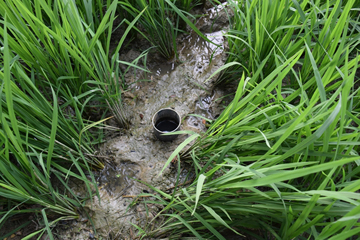RAJSHAHI, Dec 13, 2017 (BSS) – Water-saving irrigation method has started gaining popularity in the drought-prone Barind area creating high hope of reducing dependence on underground water for irrigation purposes.
Anil Saren of Uchadanga village under Godagari Upazia is very much happy over adopting “Alternate Wetting and Drying (AWD)”, a water-saving irrigation method, on his paddy farming field.
“AWD method helps save water in aquifers amidst decline of underground waterlevel,” said Saren while talking to BSS here on Tuesday.
He had to irrigate his paddy field through machine. But, now water demand was less as many farmers adopt alternative irrigation method like him. Besides, each of the farmers got one to three mounds more of paddy.
In last Irri-boro season, Saren gave 15 irrigations to one bigha of paddy field instead of the previous season’s 22 irrigations in conventional method. He also got four mounds of paddy more than that of the conventional system.
Integrated Water Resource Management (IWRM) Project financially and technically supported the farmers towards successful promotion of various water-saving irrigation methods like AWD. It also intends to make the farmers habituated towards farming less-water consuming crops in the water-stressed area.
The IWRM project is being implemented in 35 UPs and four pourasavhas in Rajshahi and Chapainawabganj districts since 2015 by DASCOH Foundation and Swiss Red Cross with financial support from Swiss Agency for Development and Cooperation- SDC.
Shukur Uddin, 43, another farmer of Solarpara village under Tanore upazila, said he has harvested 44 mounds of paddy from two bighas of land through adopting the AWD irrigation method.
Chief Executive Officer of DASCOH Akramul Haque told BSS that main thrust of the project is to build a sustainable and effective approach through farmers’ level piloting of different sustainable water resource management models through effective farmers’ participation.
He said 93 farmers had brought 115 bighas of irri-boro land under AWD irrigation system in Barind area last season in order to lessen the gradually mounting pressure on groundwater level.
Dr Shakhawat Hossain, Senior Scientific Officer of Bangladesh Agriculture Research Institute (BARI), said adoption of the method would result in a fivefold reduction in requirement for water and save 30 litres of diesel used for irrigation and produce an additional 500 kilogrammes of paddy per hectare.
AWD is a water-saving technology that farmers can apply to reduce their irrigation water consumption in rice fields without decreasing its yield. In AWD, irrigation water is applied a few days after the disappearance of the pond water. Hence, the field gets alternately flooded and non-flooded.
The number of days of non-flooded soil between irrigations can vary from one to more than 10 days depending on the number of factors such as soil type, weather and crop growth stage.



